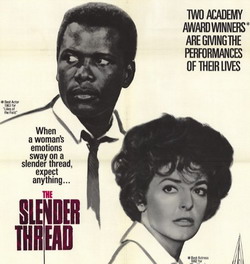
THE SLENDER THREAD
US, 1965, 98 minutes, Black and white.
Sidney Poitier, Anne Bancroft, Telly Savalas, Steven Hill.
Directed by Sidney Pollack.
The Slender Thread has been a very popular film over the years. It is a film full of hope and appreciation of life and probably will always have a strong appeal.
The film itself was a commercial venture to combine the talents of Oscar winners, Sidney Poitier and Anne Bancroft. The combination is successful, although the two never appear together. The action is by talking over the slender thread of a lifeline type phone, which, ultimately, can keep a person holding on to the slender thread of life. The film, in fact, is mainly one of a long phone call with flashbacks. This gives Anne Bancroft a chance to portray a variety of moods. Sidney Poitier is confined to the phone but is excellent in his performance. The film belongs to Poitier's best 'do-gooding' years - The Lilies of the Field (1963); A Patch of Blue (1963); To Sir With Love; Guess Who's Coming to Dinner; In the Heat of the Night (all 1967). Anne Bancroft now makes few screen appearances. They range from - The Miracle Worker; The Pumpkin Eater; Young Winston, to the famous Mrs. Robinson in The Graduate. Director Sidney Pollack has made, amongst others. This Property is Condemned (1966); They Shoot Horses Don't They (1969); Jeremiah Johnson (1972); The Way We Were (1973).
1. What does the title imply for the theme of the film?
2. The credit sequences spent some time on the city environment. What impression of city life did these sequences, and the whole film, give?
3. Did the film establish the two major characters well before the telephone call began? How was this done?
- Inga - loneliness, reckless driving?
- Alan - studying, final exams, generously manning the clinic for Dr.Cowburn?
4. Was the structure of the film effective?
5. Why did Inga attempt suicide? Was her predicament 'well communicated to the audience? Why couldn't she cope with her problems?
6. What was the significance of Mark taking Inga to the Church? What effect did this have on Inga and the audience? Why?
7. How important was the night out at the restaurant? What did Inga's excitement communicate to the audience?
8. How tragic was Inga's last day?
9. How effectively symbolic was the sequence with the children on the beach and the dying bird?
10. Why did Inga ring the Crisis Clinic? Did she only need someone with whom to talk?
11. How well did Alan handle the whole situation? How was he able to trace Inga?
12. Comment on the various aspects of the conversation and their effect.
13. Sow important for the audience was it that Inga was unaware that Alan was a Negro?
14. Did the sense of urgency and community help come across in the film?
15. Were you pleased that Inga was found in time? Did this make too much of a happy ending or was it satisfying?
16. Why did Alan not go to the hospital? What was his reaction to Mark?
17. Although the film treated sordid material - unmarried mother, marital quarrels, suicide - its tone was extremely positive. Do you agree? How effective and good is this kind of film?